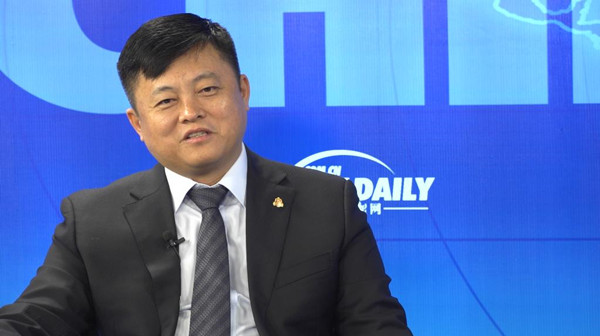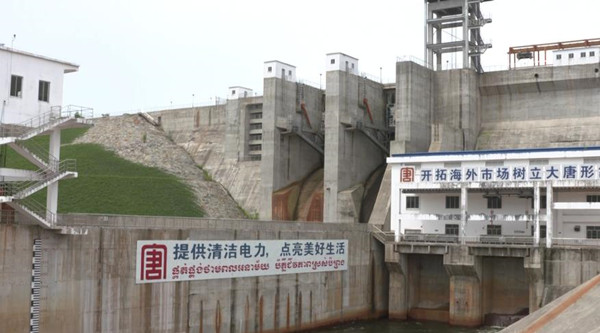Hailing Datang's success, Cambodia wants more China energy investment

Mr Tea Kong, Cambodian Minister-Counselor to China, recently shared his views with China Daily on Chinese central SOEs and China's overseas economic cooperation. [Photo/chinadaily.com.cn]
At the China-ASEAN Expo this September in Nanning, Prime Minister Hun Sen of Cambodia, the event's "Country of Honor", regaled the participants with tales of how it was the eleventh time he had led a delegation to the expo. His commitment soon paid off. In four days, his delegation had swept up deals worth $80 million with China.
The two countries had just celebrated the 60th anniversary of diplomatic ties in July, and bilateral trade had swollen to $5.8 billion in 2017, an all-time high. As its biggest trade partner and investor, China is an important ally in Cambodia's economic revitalization. Yet the Kingdom's dire situation of infrastructure development remains a big hurdle.
It's no wonder that Hun Sen took time from his tight schedule to hold an investment forum with executives from Chinese enterprises involved in Cambodia's infrastructure construction under the China-proposed Belt and Road Initiative (BRI). Among them was Chen Feihu, president of China Datang Corp, a State-owned power generator and a $25 billion Fortune Global 500 company.
Back in 2009, when Datang set out to build a hydropower dam and power grid in southwest Cambodia's tropical jungles, the challenges the engineers faced included not only the road-less hilly terrain and the debilitating weather, but also the wild beasts and gnawing boredom from weeks of isolation deep inside the forests.
"To do construction work in a place like Cambodia, as we all know, is very difficult," said Qiu Huibin, a Datang manger in charge of the local projects.
Cambodia was then in dire need of an increase in its own power supply and expansion of access to the power grid. A remedy was long overdue as the Kingdom was heavily reliant on pricey electricity imports from neighboring countries like Thailand, Vietnam and Laos. The imports rate reached an alarming 64 percent in 2011, nearly two-thirds of its electricity consumption. Even worse, large swathes of its countryside remained off-grid and dirty diesel generators were their only resort.
"The four provinces along the route from Phnom Penh to Battambang are mostly economically-deprived, and families in those regions didn't have access to power," said Tea Kong, the Cambodian Minister-Counselor to China, in an interview with China Daily.
The projects' official launch in early 2014 couldn't have been timelier. The Cambodian government had just unveiled a new five-year development plan, the Rectangular Strategy Phrase III, vowing to "reclaim full ownership of the country's destiny." At the launch ceremony, Hun Sen lauded Datang for "helping power the Cambodian battery", honoring six of its employees the prestigious medal of "Friendly Cooperation".

The Stung Atay Hydropower Project, named after the tributary in Pursat province where it’s located, is invested and constructed by China Datang Corp. [Photo provided by China Datang Corp]
The Stung Atay Hydropower Project is a two-stage power plant with a total investment of $255 million. The first involves the installation on the dam toe of two sets of ten megawatt hydro turbines and generator units, while the second stage focuses on the lower dam's powerhouse, with four more units and another one hundred megawatt capacity. To build such a concrete-and-steel mammoth deep in the rainforests, only 22 kilometers away from Cambodia's second-highest peak, was an uphill task.
The Phnom Penh-Battambang 230kV Power Transmission Project was no less arduous as the power grid winds almost 300 kilometers across the mountain ranges, connecting the capital city Phnom Penh with the four provinces of Kandal, Kampong Chhnang, Pursat and Battambang, bringing light to local residents and driving economic development along its entire route.
Since both projects operated under so-called BOT contracts, their build-operate-transfer framework met Cambodia's pressing need for capital and technology at an early stage of development, helping cultivate 132 local power technology and management personnel and create more than 10,000 jobs.
As of May 2018, the Stung Atay power plant had supplied Cambodia with nearly 1.2 billion kWh of power and nearly one third of the country's power transmission last year was carried by the Phnom Penh-Battambang power grid. The country's electricity imports rate was reduced to 22 percent in 2016, and is still declining.
Infrastructure cooperation between China and Cambodia is riding on a high tide as the BRI enters its fifth year. Cambodia's biggest hydropower dam, the Lower Sesan II, which was built by China Huaneng Group, began operations last November. Construction of a new airport in Siem Reap began this spring while China Road and Bridge Corp is ready to start a highway project from Phnom Penh to the Sihanoukville Special Economic Zone as soon as this month.
As China's reform and opening-up policy reaches its 40th anniversary, a growing legion of Chinese State-owned enterprises, under the strategic leadership of the State-owned Assets Supervision and Administration Commission, China's top regulator for State assets, are venturing into bigger markets by going oversea, adding momentum to the BRI.
In Cambodia, PM Hun Sen's government has updated its Rectangular Strategy to Phase IV, prioritizing human resources, road, water and power sectors and priming the Southeast Asian Kingdom for even closer cooperation with China's BRI.
"We encourage Chinese investors to continue to start projects in Cambodia because the country has a lot of untapped potential in many different sectors," Hun Sen said at the expo investment forum.



